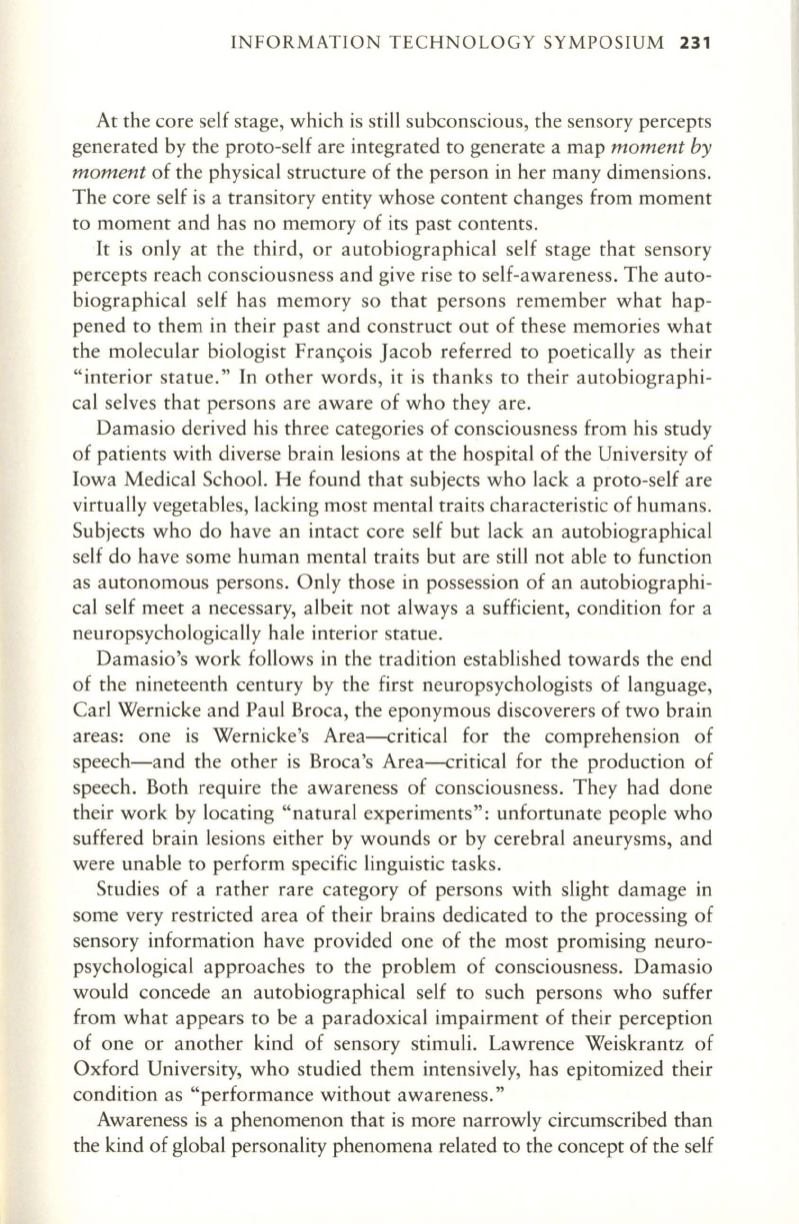
INFORMATION TECHNOLOGY SYMPOSIUM
231
At the core self stage, which is still subconscious, the sensory percepts
generated by the proto-self are integrated to generate a map
moment
by
moment
of the physical structure of the person in her many dimensions.
The core self is a transitory entity whose content changes from moment
to moment and has no memory of its past contents.
It
is only at the third, or autobiographical self stage that sensory
percepts reach consciousness and give rise to self-awareness. The auto–
biographical self has memory so that persons remember what hap–
pened to them in their past and construct out of these memories what
the molecular biologist Franc;:ois Jacob referred to poetically as their
"interior statue." In other words, it is thanks to their autobiographi–
cal selves that persons are aware of who they are.
Damasio derived his three categories of consciousness from his study
of patients with diverse brain lesions at the hospital of the University of
Iowa Medical School. He found that subjects who lack a proto-self are
virtually vegetables, lacking most mental traits characteristic of humans.
Subjects who do have an intact core self but lack an autobiographical
self do have some human mental traits but are still not able to function
as autonomous persons. Only those in possession of an autobiographi–
cal self meet a necessary, albeit not always a sufficient, condition for a
neuropsychologically hale interior statue.
Damasio's work follows in the tradition established towards the end
of the nineteenth century by the first neuropsychologists of language,
Carl Wernicke and Paul Broca, the eponymous discoverers of two brain
areas: one is Wernicke's Area-critical for the comprehension of
speech-and the other is Broca's Area-critical for the production of
speech. Both require the awareness of consciousness. They had done
their work by locating "natural experiments": unfortunate people who
suffered brain lesions either by wounds or by cerebral aneurysms, and
were unable to perform specific linguistic tasks.
Studies of a rather rare category of persons with slight damage in
some very restricted area of their brains dedicated to the processing of
sensory information have provided one of the most promising neuro–
psychological approaches to the problem of consciousness. Damasio
would concede an autobiographical self to such persons who suffer
from what appears to be a paradoxical impairment of their perception
of one or another kind of sensory stimuli. Lawrence Weiskrantz of
Oxford University, who studied them intensively, has epitomized their
condition as "performance without awareness."
Awareness is a phenomenon that is more narrowly circumscribed than
the kind of global personality phenomena related to the concept of the self


